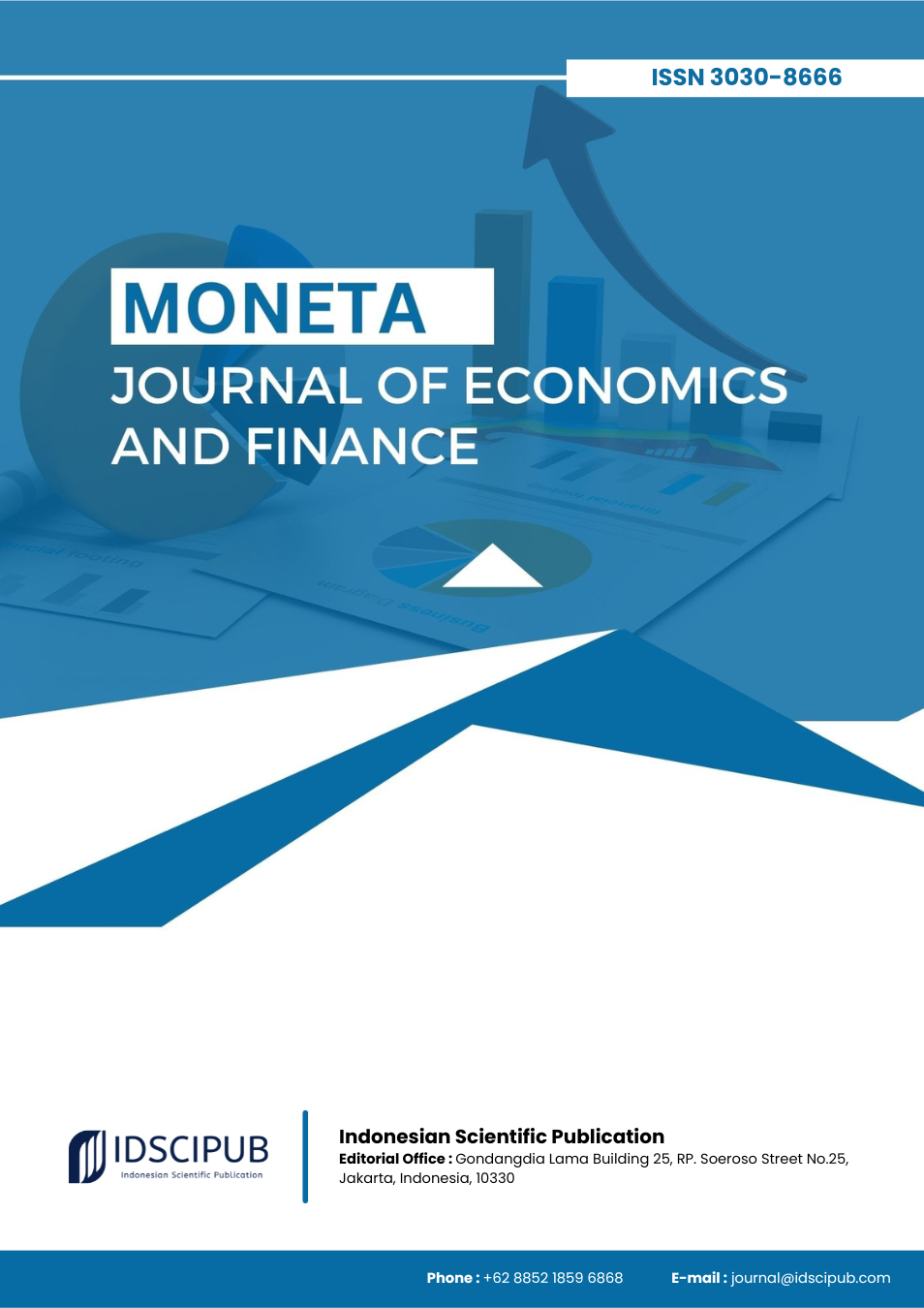Fiscal Transfers and the Persistence of Regional Inequality: A Critical Review of Indonesia's Intergovernmental Funding System
DOI:
https://doi.org/10.61978/moneta.v3i4.822Keywords:
Fiscal Decentralization, Intergovernmental Transfers, Regional Inequality, DAU, DAK, Indonesia, Performance Based AllocationAbstract
This study critically examines the effectiveness of Indonesia’s intergovernmental fiscal transfer mechanisms primarily the General Allocation Fund (DAU) and the Special Allocation Fund (DAK) in addressing persistent regional inequality since the implementation of the post Otonomi Daerah decentralization reforms. The research aims to assess whether these fiscal instruments have fulfilled their redistributive mandate and to identify structural and governance related barriers that limit their impact. Employing a mixed-method approach with secondary data, the study analyzes fiscal gaps, transfer effectiveness, and regional disparities. The analysis combines statistical indices (Gini coefficient, Theil index) with case studies from West Sumatra, East Java, and Eastern Indonesia, complemented by international comparisons and policy evaluations. The findings show that DAU and DAK have expanded fiscal flows to poorer regions but remain constrained by formulaic designs that overlook socio-economic diversity. Administrative inefficiencies, weak planning capacity, and limited accountability reduce fund utilization. Comparative international models suggest alternatives through performance-based and needs-responsive allocation formulas. In conclusion, Indonesia's fiscal transfer framework must evolve from a volume based to an outcome driven model. By incorporating equity sensitive criteria, decentralizing planning autonomy, and strengthening transparency, fiscal transfers can transition from redistributive tools to transformative instruments that narrow regional inequality and foster inclusive national development.
References
Aida, A., Hariyanti, D., & Sumiyarti. (2023). Analisis Tax Effort Daerah Di Indonesia. Media Ekonomi, 30(2). https://doi.org/10.25105/me.v30i2.13818 DOI: https://doi.org/10.25105/me.v30i2.13818
Akita, T. (2015). Educational Expansion and the Role of Education in Expenditure Inequality in Indonesia Since the 1997 Financial Crisis. Social Indicators Research, 130(3), 1165–1186. https://doi.org/10.1007/s11205-015-1208-y DOI: https://doi.org/10.1007/s11205-015-1208-y
Akita, T., Riadi, A. A., & Rizal, A. (2021). Fiscal Disparities in Indonesia in the Decentralization Era: Does General Allocation Fund Equalize Fiscal Revenues? Regional Science Policy & Practice, 13(6), 1842–1866. https://doi.org/10.1111/rsp3.12326 DOI: https://doi.org/10.1111/rsp3.12326
Anak Agung Gde Mantra Suarjana, & Dewi, N. I. K. (2018). Pengaruh Pendapatan Asli Daerah (PAD) Dan Dana Perimbangan Terhadap Pengembangan Infrastruktur Pada Pemerintah Provinsi Bali. Jurnal Bisnis Dan Kewirausahaan, 14(2), 66–79. https://doi.org/10.31940/jbk.v14i2.1040 DOI: https://doi.org/10.31940/jbk.v14i2.1040
Arham, M. A. (2014). Kebijakan Desentralisasi Fiskal, Pergeseran Sektoral, Dan Ketimpangan Antarkabupaten/Kota Di Sulawesi Tengah. Jurnal Ekonomi Dan Pembangunan Indonesia, 14(2), 145–167. https://doi.org/10.21002/jepi.v14i2.437 DOI: https://doi.org/10.21002/jepi.v14i2.437
Azaki, N., & Lutfi, A. (2023). Capital Grants for Local Infrastructure Provision in Perspective of Allocative Efficiency: Evidence From Indonesia. Journal of Public Administration Studies, 8(2), 1–9. https://doi.org/10.21776/ub.jpas.2023.008.02.1 DOI: https://doi.org/10.21776/ub.jpas.2023.008.02.1
Azis, F., Isma, A., & Andi Naila Quin Azisah Alisyahbana. (2023). Determinants of Government Spending on Regional Development Inequality in the East Indonesia Area. Ekonomis Journal of Economics and Business, 7(2), 944. https://doi.org/10.33087/ekonomis.v7i2.1172 DOI: https://doi.org/10.33087/ekonomis.v7i2.1172
Damayanti, A., Mulyanto, M., & Samudro, B. R. (2024). Determinants of Human Development Index (HDI) in City Districts of Central Java Province. Journal of Economics Finance and Management Studies, 07(08). https://doi.org/10.47191/jefms/v7-i8-26 DOI: https://doi.org/10.47191/jefms/v7-i8-26
Damayanti, K. E., Dewi, Y. L. R., Wiboworini, B., & Widyaningsih, V. (2024). Animal Protein on Stunting Prevention: A Narrative Review. Iop Conference Series Earth and Environmental Science, 1292(1), 012027. https://doi.org/10.1088/1755-1315/1292/1/012027 DOI: https://doi.org/10.1088/1755-1315/1292/1/012027
Farida, N. (2021). Fiscal Decentralization, Economic Growth and Regional Development Inequality in Eastern Indonesia. Journal of Indonesian Applied Economics, 9(2), 1–9. https://doi.org/10.21776/ub.jiae.2021.009.02.1 DOI: https://doi.org/10.21776/ub.JIAE.2021.009.02.1
Fatmasari, D., Harjadi, D., & Hidayat, A. (2022). Analysis of Economic Improvement to Reduce Poverty in 2016-2020. Khazanah Sosial, 4(4), 757–764. https://doi.org/10.15575/ks.v4i4.23445 DOI: https://doi.org/10.15575/ks.v4i4.23445
Hill, H., & Vidyattama, Y. (2016). Regional Development Dynamics in Indonesia Before and After the ‘Big Bang’ Decentralization. The Singapore Economic Review, 61(02), 1640027. https://doi.org/10.1142/s0217590816400270 DOI: https://doi.org/10.1142/S0217590816400270
Indra, I., Nazara, S., Hartono, D., & Sumarto, S. (2018). Expenditure Inequality and Polarization in Indonesia, 2002-2012. International Journal of Social Economics, 45(10), 1469–1486. https://doi.org/10.1108/ijse-02-2017-0051 DOI: https://doi.org/10.1108/IJSE-02-2017-0051
Krisnadi, M. F. (2023). Strengthening Social Protection Network in Indonesia: A Comprehensive Analysis of Coverage, Targeting, and Funding Towards an Inclusive Welfare State. Umygrace, 3(1), 29–37. https://doi.org/10.18196/umygrace.v3i1.529 DOI: https://doi.org/10.18196/umygrace.v3i1.529
Malini, H. (2021). Factors Affecting Capital Expenditures and Community Welfare in Kalimantan. Jurnal Reksa Rekayasa Keuangan Syariah Dan Audit, 8(2), 78. https://doi.org/10.12928/j.reksa.v8i2.4316 DOI: https://doi.org/10.12928/j.reksa.v8i2.4316
Nababan, H., Hasan, Md. Z., Marthias, T., Dhital, R., Rahman, A., & Anwar, I. (2017). Trends and Inequities in Use of Maternal Health Care Services in Indonesia, 1986−2012. International Journal of Women S Health, Volume 10, 11–24. https://doi.org/10.2147/ijwh.s144828 DOI: https://doi.org/10.2147/IJWH.S144828
Panjawa, J. L., Guritno, D. C., Sugiharti, Rr. R., Kurniawan, M. L. A., & Damayanti, S. A. (2023). Measuring Inequality Using J-Bonet Index: What Can We Learn From Regional Data? Jejak, 16(1). https://doi.org/10.15294/jejak.v16i1.38850 DOI: https://doi.org/10.15294/jejak.v16i1.38850
Pelaburan, P., Swasta, A. D., Hakim, D. R., Rosini, I., Pdi, W., & Fdi, B. (2022). Regional Income Inequality in Indonesia: The Role of Public and Private Investment. Jurnal Ekonomi Malaysia, 56(3). https://doi.org/10.17576/jem-2022-5603-05 DOI: https://doi.org/10.17576/JEM-2022-5603-05
Pradana, A. C. T., & Mun’im, A. (2022). The Effect of Local Revenue and Balancing Funds on the Economy of Bali Province in 2012-2019. Jurnal Bina Praja, 14(3), 439–451. https://doi.org/10.21787/jbp.14.2022.439-451 DOI: https://doi.org/10.21787/jbp.14.2022.439-451
Régina, Sinring, B., & Arifin, A. (2020). Analysis the Effects of Poverty, General Allocation Fund and Economic Growth to Human Development Index (Hdi) in Indonesia. Jurnal Economic Resource, 3(2). https://doi.org/10.57178/jer.v3i2.300 DOI: https://doi.org/10.57178/jer.v3i2.300
Sarjoko, D., Khusaini, Moh., & Sakti, R. K. (2022). Vertical Fiscal Balance and Local Fiscal Discipline in Indonesia. Journal of International Conference Proceedings, 5(2), 150–161. https://doi.org/10.32535/jicp.v5i2.1681 DOI: https://doi.org/10.32535/jicp.v5i2.1681
Siahaan, C. J., Taufiqurahman, M. K., Andrianto, B., & Iman, M. N. (2020). Unequal Economic Growth Between Regions in Indonesia: Hard Infrastructure or Soft Infrastructure? International Journal of Business and Administrative Studies, 6(2). https://doi.org/10.20469/ijbas.6.10004-2 DOI: https://doi.org/10.20469/ijbas.6.10004-2
Simson, R., & Savage, M. (2019). The Global Significance of National Inequality Decline. Third World Quarterly, 41(1), 20–41. https://doi.org/10.1080/01436597.2019.1662287 DOI: https://doi.org/10.1080/01436597.2019.1662287
Suparmi, S., Kusumawardani, N., Nambiar, D., Trihono, & Hosseinpoor, A. R. (2018). Subnational Regional Inequality in the Public Health Development Index in Indonesia. Global Health Action, 11(sup1), 41–53. https://doi.org/10.1080/16549716.2018.1500133 DOI: https://doi.org/10.1080/16549716.2018.1500133
Tana, A., Kalangi, L., & Wokas, H. R. N. (2024). Analysis of Transfer Funds on Regional Expenditure of North Sulawesi Provincial Government Before and During Covid-19 Pandemic. Accounting and Finance Studies, 4(1), 34–52. https://doi.org/10.47153/afs41.8852024 DOI: https://doi.org/10.47153/afs41.8852024
Veruswati, M., Asyary, A., Nadjib, M., & Achadi, A. (2018). Current Activities in Smokes-Free Zone Policy: A Tobacco Control Care Reviews in Indonesia. Family Medicine & Primary Care Review, 20(4), 385–388. https://doi.org/10.5114/fmpcr.2018.79352 DOI: https://doi.org/10.5114/fmpcr.2018.79352
Zhang, M. (2022). Research on the Sustainable Development of China’s Street Vendor Economy. https://doi.org/10.33422/6th.icbmeconf.2022.06.15 DOI: https://doi.org/10.33422/6th.icbmeconf.2022.06.15
Zhou, R., Chen, H., & Chen, H. (2024). Optimal Reservation Volume of Urban Roads Based on Travel Reservation Strategy. Journal of Advanced Transportation, 2024(1). https://doi.org/10.1155/2024/6628446 DOI: https://doi.org/10.1155/2024/6628446






